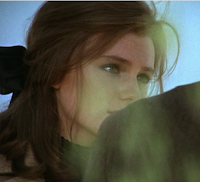 |
| Tyrone Power in full Zorro guise. |
For me, Errol Flynn dominated the swashbuckler genre from his appearance in
Captain Blood (1935) through
Against All Flags (1952). However, I freely admit that I can't envision him as the lead in one of the best swashbuckler pictures of that period. Simply put,
The Mark of Zorro is not a Flynn vehicle--but it fits Tyrone Power like a glove...or rather, a black mask with holes for the eyes.
There may be some of you that argue
The Mark of Zorro isn't really a swashbuckler film at all. You would be wrong, of course. The setting may be Los Angeles in the early 19th century, but the plot and sword fights are straight out of Sherwood Forest with perhaps a dash of
The Scarlet Pimpernel.
Power plays Diego de Vega, a Spanish officer-in-training known for his prowess with a sword and his cocky attitude (due to his American upbringing, his nickname is the California Cockerel). When Diego's father suddenly calls him back to California, the dispirited young man tells his friends: "Think of me in the land of gentle missions, happy peons, sleepy caballeros, and everlasting boredom."
 |
| Diego playing the aristocratic dandy. |
Of course, shortly after his arrival back home, Diego learns that things have changed for the worse. A greedy buffoon has replaced his father as alcalde (i.e., magistrate), the cruel Captain Pasquale mistreats the villagers, and taxes are high and going higher. Assessing the situation quickly, Diego decides to play the role of an aristocratic fop more interested in fabrics, scents, and lotions than politics. His deceit not only fools the alcalde and Pasquale, but also Diego's parents. Meanwhile, the young Spaniard dons a black mask and takes up the people's cause as the defiant Zorro--who steals from the rich and distributes the gold to the villagers through the local padre (Eugene Pallette).
 |
| No, Eugene Pallette is not playing Friar Tuck! |
Although based on Johnston McCulley's serialized 1919 novel
The Curse of Capistrano,
The Mark of Zorro is highly derivative. The premise of a bold hero disguised as a fop has appeared in numerous literary works, most notably Baroness Orczy's
The Scarlet Pimpernel. Not only is the plot lifted from the Robin Hood legend, but whole scenes are strongly reminiscent of
The Adventures of Robin Hood (1938), such as robbing the coach, appearing on his love's balcony, and the climatic sword duel with--yes--Basil Rathbone. I would also be remiss to not mention Douglas Fairbanks' splendid 1920 silent
Mark of Zorro, which undoubtedly provided the impetus for this remake.
 |
| Power and Rathbone cross swords. |
Yet, while
The Mark of Zorro lacks originality, it is executed with flair (underlined by Alfred Newman's rousing Oscar-nominated music score). I disagree with Leslie Halliwell, one of my favorite film critics, who wrote in
Halliwell's Harvest that Diego is "unsatisfactorily played by a chubby young Tyrone Power, who simply can't manage, without unseemly grimaces, the elements of self-mockery which came so easily to Errol Flynn." I think Power is well-cast as both the effeminate Diego and the robust Zorro. He certainly handles a sword well, with the big showdown opposite Rathbone (a fine fencer in real life) ranking as the film's highlight.
 |
| Linda Darnell dressed in black and white. |
The rest of the cast lends solid support, except for the lovely Linda Darnell. Granted, her role is barely developed as the film's heroine (in contrast to Merle Oberon's prominent role in the 1934
Scarlet Pimpernel). My chief complaint is that her line readings simply sound too contemporary. Perhaps, it was just a young actress still learning her craft--this was easily her biggest part to date.
Michael Curtiz might have directed a more lively film, but Rouben Mamoulian adds his own distinctive touches. His use of deep black contrasted against white is highly effective, especially when Zorro makes his first appearance--dressed head to foot in black aboard his black stallion as he rides swiftly through a sleepy village filled with drab off-white colors. (I have no idea why Fox bothered to colorize the film for one of its DVD releases, thereby ruining Mamoulian's photography.)
The success of
The Mark of Zorro led to other action hero roles for Power (e.g.,
Captain from Castille,
Prince of Foxes,
The Black Rose). Zorro continued to be a popular character and has been played by: Guy Williams (in a Walt Disney TV series); Frank Langella (in a made-for-TV movie); George Hamilton (in a spoof); Antonio Banderas; and others.
 Bullitt was not the film that established the Steve McQueen "cool quotient." Steve was displaying coolness earlier in the 1960s in movies such as The Great Escape (1963), The Cincinnati Kid (1965), and The Thomas Crown Affair (1968). Heck, his character was even known as The Cooler King in The Great Escape (okay, that was a different kind of "cooler"). Yet, if Steve was already cool, Bullitt elevated him to a new level and became perhaps his most iconic film. Think of Bullitt and two things spring to mind: the high-speed car chase through San Francisco and the poster with McQueen in a dark turtleneck with shoulder holster looking...yes...pretty damn cool.
Bullitt was not the film that established the Steve McQueen "cool quotient." Steve was displaying coolness earlier in the 1960s in movies such as The Great Escape (1963), The Cincinnati Kid (1965), and The Thomas Crown Affair (1968). Heck, his character was even known as The Cooler King in The Great Escape (okay, that was a different kind of "cooler"). Yet, if Steve was already cool, Bullitt elevated him to a new level and became perhaps his most iconic film. Think of Bullitt and two things spring to mind: the high-speed car chase through San Francisco and the poster with McQueen in a dark turtleneck with shoulder holster looking...yes...pretty damn cool.







































